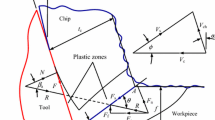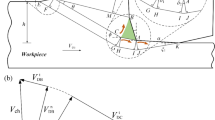Abstract
To understand the nature of chip formation in cutting, the study of temperature field in the uncut chip layer of the workpiece is extremely important. In this study, the temperature field for the uncut chip layer is modeled using the heat source projection at different depths of the layer along the cutting speed direction to obtain the different heating times of points at corresponding depths. It is based on the model of the cutting temperature field in the machined surface layer of the workpiece, as proposed in the previous paper of the authors. The temperature distribution in both uncut chip and machined surface layers are thus achieved, and the temperature penetration depths in the machined surface layer are compared with experiment results. The results show that the computed isotherms on the boundary of the uncut chip and machined surface layers are continuous and smooth, indicating that the temperature field model for the uncut chip layer is correct. The temperature field for the nonplanar primary shear plane heat source is also modeled by introducing the curve integral. This is considerably significant in the conduct of further research on the temperature field in micromachining considering size effects and in machining using restricted contact tools, such as groove-type chip breaker tool, double-rake-angled tool, rounded-edge tool, and tool with built-up edge.









Similar content being viewed by others
Abbreviations
- B :
-
Fraction of shear plane heat conducted into workpiece
- B rubbing :
-
Fraction of tool flank–workpiece rubbing heat conducted into workpiece
- α :
-
Rake angle (°)
- q shear :
-
Heat liberation intensity in shear plane (W/mm2)
- q rubbing :
-
Heat liberation intensity in tool flank–workpiece rubbing zone (W/mm2)
- λ :
-
Thermal conductivity (W/(mm °C))
- F t :
-
Feed force (N)
- F cw :
-
Frictional force between tool flank and workpiece machined surface (N).
- F c :
-
Cutting force (N)
- L :
-
Shear plane heat source width (mm)
- VB :
-
Width of tool flank–workpiece contact zone (mm)
- t c :
-
Cut depth or undeformed chip thickness (mm)
- φ :
-
Shear angle (°)
- w :
-
Cut width (mm)
- V :
-
Velocity of moving plane heat source or cutting speed (mm/s)
- a :
-
Thermal diffusivity (mm2/s)
- μ :
-
Friction coefficient between tool flank and workpiece machined surface
- N th :
-
Thermal number (=tcV/a)
- K 0 :
-
Modified Bessel function of second kind of order zero
- K ω :
-
Dimensionless coefficient of K0 modification
- \( {K}_{\omega}^{shear} \) :
-
Dimensionless coefficient of K0 modification corresponding to shear plane heat source
- \( {K}_{\omega}^{\mathrm{rubbing}} \) :
-
Dimensionless coefficient of K0 modification form corresponding to tool flank–workpiece rubbing heat source
- t :
-
Heating time (s)
- t shear :
-
Heating time of point M(x, z) caused by shear plane heat source (s)
- t rubbing :
-
Heating time of point M(x, z) caused by tool flank–workpiece rubbing heat source (s)
References
Shaw MC (2005) Metal cutting principles. Oxford University Press, New York
Zhou Z (1991) (in Chinese), Metal cutting theory. Machinery Industry Press, Beijing
Huang K, Yang W, Chen Q (2015) Analytical model of stress field in workpiece machined surface layer in orthogonal cutting. Int J Mech Sci 103:127–140. https://doi.org/10.1016/j.ijmecsci.2015.08.020
Huang K, Yang W (2016) Analytical modeling of residual stress formation in workpiece material due to cutting. Int J Mech Sci 114:21–34. https://doi.org/10.1016/j.ijmecsci.2016.04.018
Huang K, Yang W (2016) Analytical model of temperature field in workpiece machined surface layer in orthogonal cutting. J Mater Process Technol 229:375–389. https://doi.org/10.1016/j.jmatprotec.2015.07.008
Chen G, Ren C, Zhang P, Cui K, Li Y (2013) Measurement and finite element simulation of micro-cutting temperatures of tool tip and workpiece. Int J Mach Tools Manuf 75:16–26. https://doi.org/10.1016/j.ijmachtools.2013.08.005
List G, Sutter G, Bouthiche A (2012) Cutting temperature prediction in high speed machining by numerical modelling of chip formation and its dependence with crater wear. Int J Mach Tools Manuf 54-55:1–9. https://doi.org/10.1016/j.ijmachtools.2011.11.009
Shet C, Deng X (2000) Finite element analysis of the orthogonal metal cutting process. J Mater Process Technol 105(1):95–109
Mamalis A, Horvath M, Branis A, Manolakos D (2001) Finite element simulation of chip formation in orthogonal metal cutting. J Mater Process Technol 110(1):19–27. https://doi.org/10.1016/S0924-0136(00)00861-X
Movahhedy M, Gadala M, Altintas Y (2000) Simulation of the orthogonal metal cutting process using an arbitrary Lagrangian–Eulerian finite-element method. J Mater Process Technol 103(2):267–275
Zhang Y, Mabrouki T, Nelias D, Courbon C, Rech J, Gong Y (2012) Cutting simulation capabilities based on crystal plasticity theory and discrete cohesive elements. J Mater Process Technol 212(4):936–953. https://doi.org/10.1016/j.jmatprotec.2011.12.001
Jin X, Altintas Y (2011) Slip-line field model of micro-cutting process with round tool edge effect. J Mater Process Technol 211(3):339–355. https://doi.org/10.1016/j.jmatprotec.2010.10.006
Komanduri R, Hou ZB (2000) Thermal modeling of the metal cutting process: part I—temperature rise distribution due to shear plane heat source. Int J Mech Sci 42(9):1715–1752. https://doi.org/10.1016/S0020-7403(99)00070-3
Komanduri R, Hou ZB (2001) Thermal modeling of the metal cutting process—part III: temperature rise distribution due to the combined effects of shear plane heat source and the tool–chip interface frictional heat source. Int J Mech Sci 43(1):89–107. https://doi.org/10.1016/S0020-7403(99)00105-8
Komanduri R, Hou ZB (2001) Thermal modeling of the metal cutting process—part II: temperature rise distribution due to frictional heat source at the tool–chip interface. Int J Mech Sci 43(1):57–88. https://doi.org/10.1016/S0020-7403(99)00104-6
Huang K, Yang W (2017) Analytical analysis of the mechanism of effects of machining parameter and tool parameter on residual stress based on multivariable decoupling method. Int J Mech Sci 128-129:659–679. https://doi.org/10.1016/j.ijmecsci.2017.05.031
Fang N, Jawahir IS, Oxley PLB (2001) A universal slip-line model with non-unique solutions for machining with curled chip formation and a restricted contact tool. Int J Mech Sci 43(2):557–580. https://doi.org/10.1016/S0020-7403(99)00117-4
Fang N (2002) Machining with tool–chip contact on the tool secondary rake face—part I: a new slip-line model. Int J Mech Sci 44(11):2337–2354. https://doi.org/10.1016/s0020-7403(02)00185-6
Fang N (2002) Machining with tool–chip contact on the tool secondary rake face—part II: analysis and discussion. Int J Mech Sci 44(11):2355–2368. https://doi.org/10.1016/s0020-7403(02)00184-4
Fang N (2003) Slip-line modeling of machining with a rounded-edge tool—part II: analysis of the size effect and the shear strain-rate. J Mech Phys Solids 51(4):743–762. https://doi.org/10.1016/s0022-5096(02)00061-3
Fang N (2003) Slip-line modeling of machining with a rounded-edge tool—part I: new model and theory. J Mech Phys Solids 51(4):715–742. https://doi.org/10.1016/s0022-5096(02)00060-1
Fang N, Dewhurst P (2005) Slip-line modeling of built-up edge formation in machining. Int J Mech Sci 47(7):1079–1098. https://doi.org/10.1016/j.ijmecsci.2005.02.008
Fang N, Jawahir IS (2002) Analytical predictions and experimental validation of cutting force ratio, chip thickness, and chip back-flow angle in restricted contact machining using the universal slip-line model. Int J Mach Tools Manuf 42(6):681–694. https://doi.org/10.1016/S0890-6955(02)00006-8
Fang N, Jawahir IS (2002) An analytical predictive model and experimental validation for machining with grooved tools incorporating the effects of strains, strain-rates, and temperatures. CIRP Ann - Manuf Technol 51(1):83–86. https://doi.org/10.1016/s0007-8506(07)61471-1
Fang N, Jawahir IS (2001) A new methodology for determining the stress state of the plastic region in machining with restricted contact tools. Int J Mech Sci 43(8):1747–1770. https://doi.org/10.1016/S0020-7403(01)00017-0
Huang K, Yang W, Chen Q, He S (2016) An experimental investigation of temperature distribution in workpiece machined surface layer in turning. Int J Adv Manuf Technol 85(5):1207–1215. https://doi.org/10.1007/s00170-015-8016-z
Zhou R, Yang W, Yang K (2016) Force prediction models for helical end milling of nickel-aluminium bronze. Int J Adv Manuf Technol 86(5):1487–1498. https://doi.org/10.1007/s00170-015-8261-1
Funding
This work is supported by the Major State Basic Research Development Program of China (973 Program, Grant No. 2014CB046704).
Author information
Authors and Affiliations
Corresponding author
Additional information
Publisher’s note
Springer Nature remains neutral with regard to jurisdictional claims in published maps and institutional affiliations.
Rights and permissions
About this article
Cite this article
Gao, Y., Huang, K. & Yang, W. Analytical model of cutting temperature field in workpiece including uncut chip layer. Int J Adv Manuf Technol 107, 3943–3952 (2020). https://doi.org/10.1007/s00170-020-05260-7
Received:
Accepted:
Published:
Issue Date:
DOI: https://doi.org/10.1007/s00170-020-05260-7




